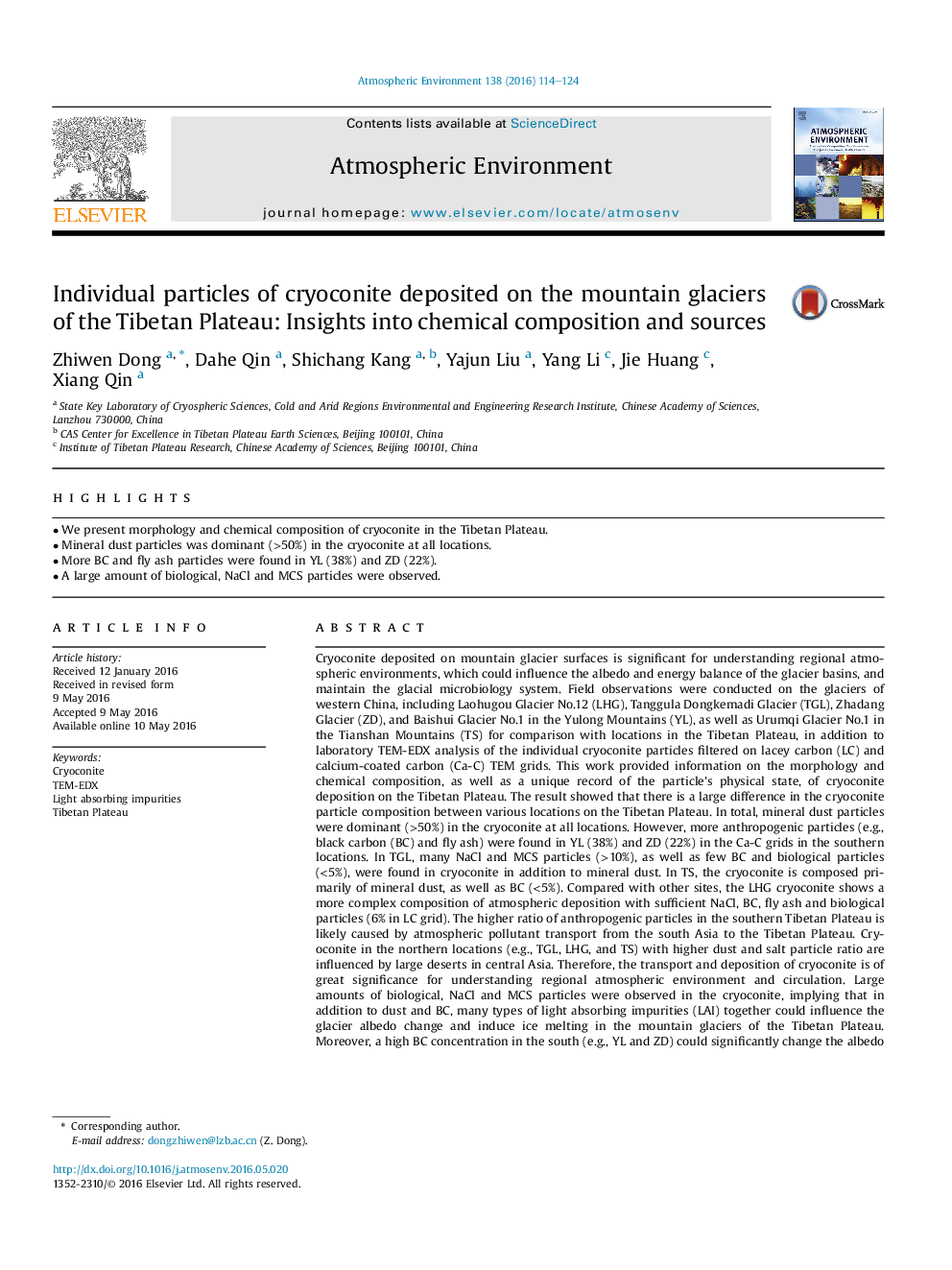| کد مقاله | کد نشریه | سال انتشار | مقاله انگلیسی | نسخه تمام متن |
|---|---|---|---|---|
| 6336534 | 1620336 | 2016 | 11 صفحه PDF | دانلود رایگان |
عنوان انگلیسی مقاله ISI
Individual particles of cryoconite deposited on the mountain glaciers of the Tibetan Plateau: Insights into chemical composition and sources
ترجمه فارسی عنوان
ذرات فردی کریوکوئینیتی که در یخچال های کوهستانی پلاتو تبت قرار گرفته اند: اطلاعات در مورد ترکیبات شیمیایی و منابع
دانلود مقاله + سفارش ترجمه
دانلود مقاله ISI انگلیسی
رایگان برای ایرانیان
موضوعات مرتبط
مهندسی و علوم پایه
علوم زمین و سیارات
علم هواشناسی
چکیده انگلیسی
Cryoconite deposited on mountain glacier surfaces is significant for understanding regional atmospheric environments, which could influence the albedo and energy balance of the glacier basins, and maintain the glacial microbiology system. Field observations were conducted on the glaciers of western China, including Laohugou Glacier No.12 (LHG), Tanggula Dongkemadi Glacier (TGL), Zhadang Glacier (ZD), and Baishui Glacier No.1 in the Yulong Mountains (YL), as well as Urumqi Glacier No.1 in the Tianshan Mountains (TS) for comparison with locations in the Tibetan Plateau, in addition to laboratory TEM-EDX analysis of the individual cryoconite particles filtered on lacey carbon (LC) and calcium-coated carbon (Ca-C) TEM grids. This work provided information on the morphology and chemical composition, as well as a unique record of the particle's physical state, of cryoconite deposition on the Tibetan Plateau. The result showed that there is a large difference in the cryoconite particle composition between various locations on the Tibetan Plateau. In total, mineral dust particles were dominant (>50%) in the cryoconite at all locations. However, more anthropogenic particles (e.g., black carbon (BC) and fly ash) were found in YL (38%) and ZD (22%) in the Ca-C grids in the southern locations. In TGL, many NaCl and MCS particles (>10%), as well as few BC and biological particles (<5%), were found in cryoconite in addition to mineral dust. In TS, the cryoconite is composed primarily of mineral dust, as well as BC (<5%). Compared with other sites, the LHG cryoconite shows a more complex composition of atmospheric deposition with sufficient NaCl, BC, fly ash and biological particles (6% in LC grid). The higher ratio of anthropogenic particles in the southern Tibetan Plateau is likely caused by atmospheric pollutant transport from the south Asia to the Tibetan Plateau. Cryoconite in the northern locations (e.g., TGL, LHG, and TS) with higher dust and salt particle ratio are influenced by large deserts in central Asia. Therefore, the transport and deposition of cryoconite is of great significance for understanding regional atmospheric environment and circulation. Large amounts of biological, NaCl and MCS particles were observed in the cryoconite, implying that in addition to dust and BC, many types of light absorbing impurities (LAI) together could influence the glacier albedo change and induce ice melting in the mountain glaciers of the Tibetan Plateau. Moreover, a high BC concentration in the south (e.g., YL and ZD) could significantly change the albedo of snow and ice, at a greater rate than dust, causing significant melting of the glaciers under global warming.
ناشر
Database: Elsevier - ScienceDirect (ساینس دایرکت)
Journal: Atmospheric Environment - Volume 138, August 2016, Pages 114-124
Journal: Atmospheric Environment - Volume 138, August 2016, Pages 114-124
نویسندگان
Zhiwen Dong, Dahe Qin, Shichang Kang, Yajun Liu, Yang Li, Jie Huang, Xiang Qin,
